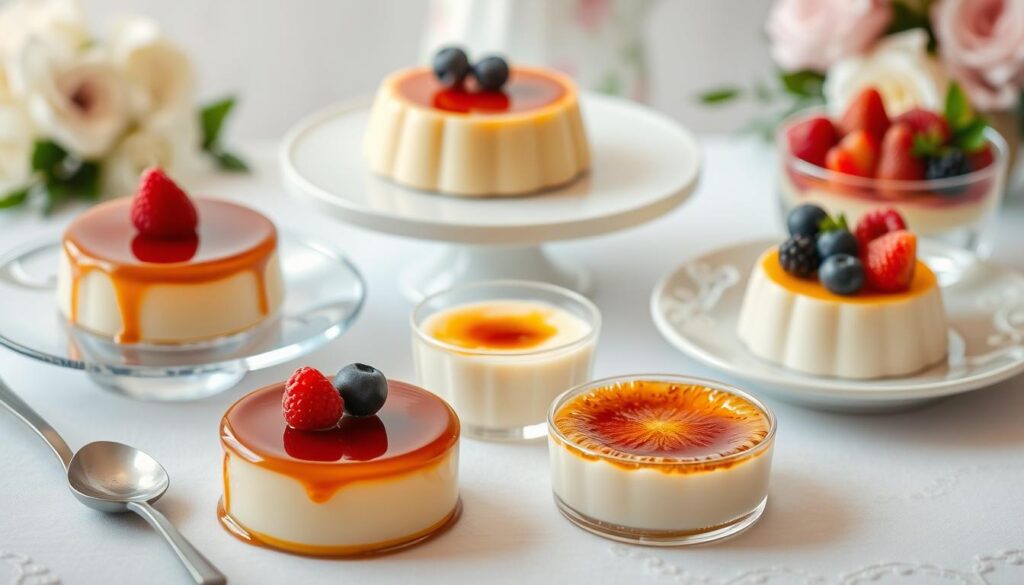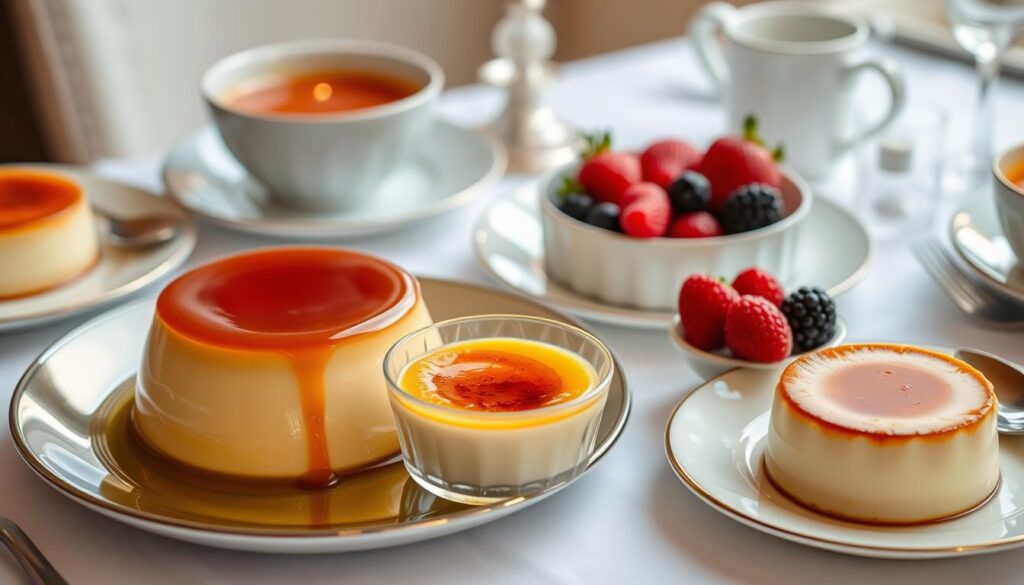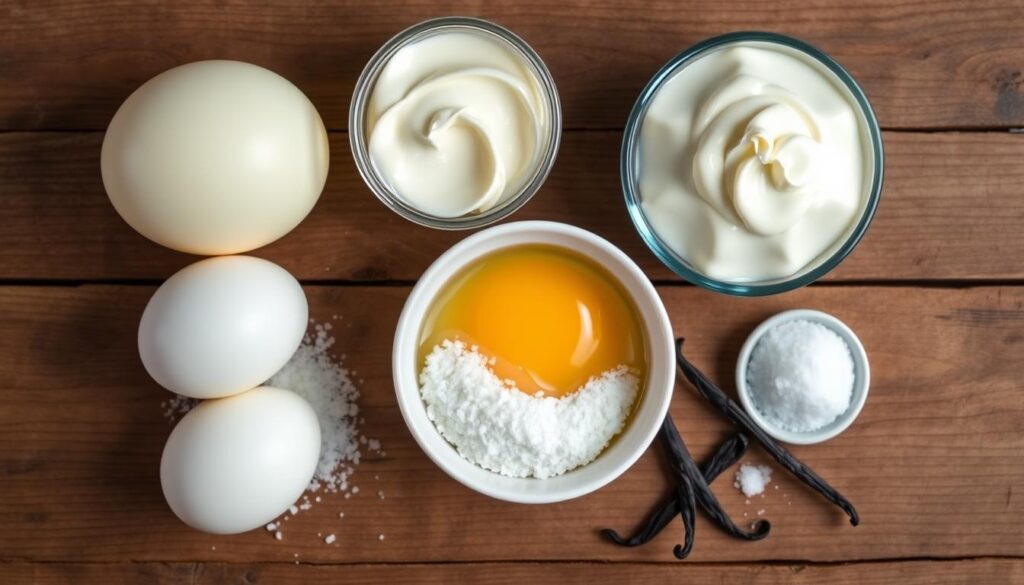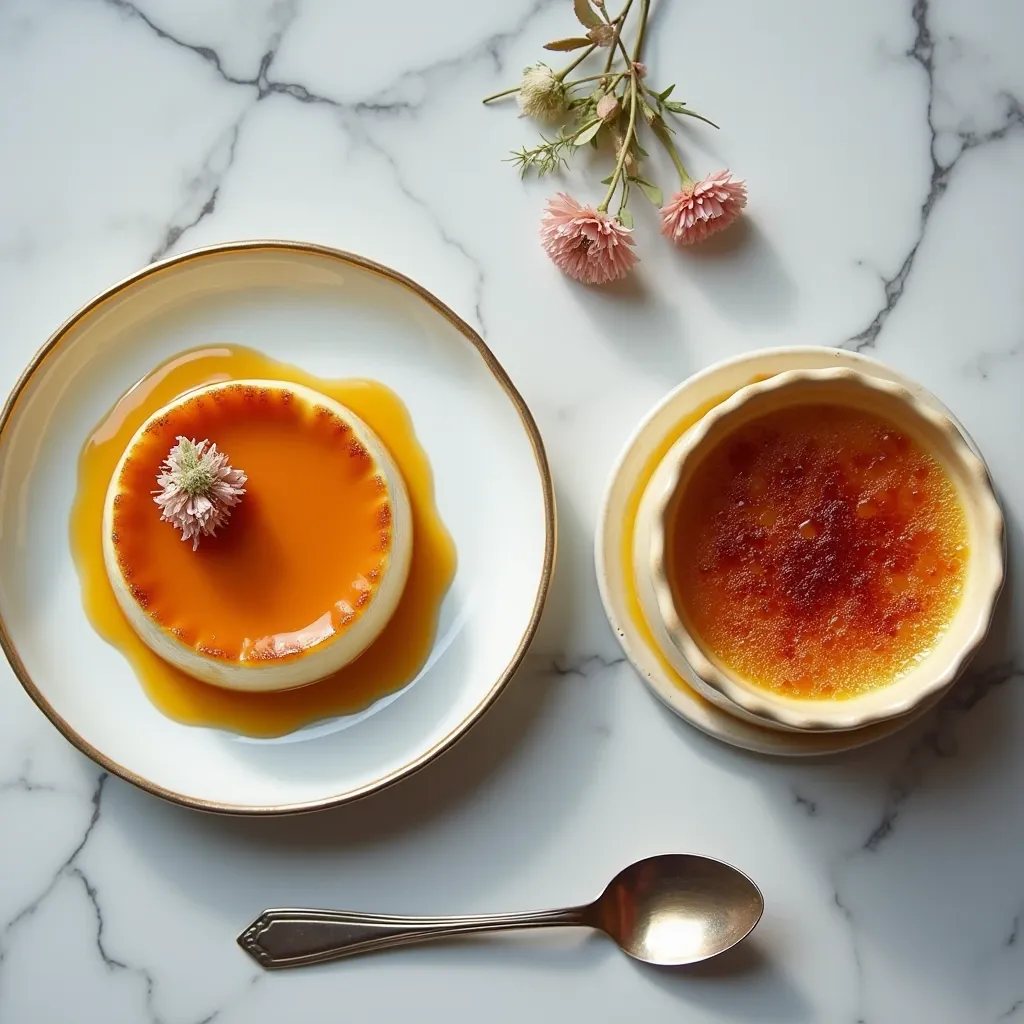Get ready for a tasty adventure in the world of custard desserts. Crème brûlée and flan are two famous treats. They both have a smooth texture and rich taste, but they’re made differently and come from different places.
Crème brûlée has a caramelized sugar top, while flan has a soft caramel coating. These desserts give you a special treat for your taste buds.
Crème brûlée comes from France and has a custard base with a caramelized sugar top. Flan, on the other hand, is from Latin America. It has a creamy custard with a liquid caramel sauce on top.
These differences change how the desserts taste and feel. They also show the unique cultures behind them.

Key Takeaways
- Crème brûlée and flan are both classic custard-based desserts with distinct origins and characteristics.
- Crème brûlée is a French creation with a rich, creamy custard topped with a hard caramelized sugar crust.
- Flan is a popular Latin American dessert featuring a dense, sweet custard with a soft, liquid caramel topping.
- The preparation methods, ingredient ratios, and serving styles differ between these two beloved custard delights.
- Understanding the nuances between crème brûlée and flan can enhance your appreciation for these timeless, egg-based desserts.
Introduction to Classic Custard Desserts
Custard desserts have a long history, starting with ancient civilizations. They evolved from the flan of ancient Rome to the crème brûlée of France. These desserts show how global culinary traditions are connected.
They are key in worldwide cuisine, blending texture and flavor. This mix has delighted dessert lovers for centuries.
Origins of Custard-Based Desserts
The history of custard desserts begins in ancient Rome. There, flan, a baked custard tart, was loved by many. As time went on, these desserts spread across Europe and the world.
Each place made its own version. France has crème brûlée, Italy has panna cotta and zabaglione. These are just a few examples of custard desserts from different cultures.
Cultural Significance in Global Cuisine
Custard desserts are important in global cuisine. They show how culinary traditions are connected. Flans from Latin America and clafoutis from France are examples.
These desserts are part of many cultures. They symbolize hospitality, celebration, and shared heritage. Their creamy texture and comforting flavors make them loved everywhere.

“Custard desserts are a testament to the enduring power of culinary traditions, transcending borders and uniting people through the universal language of delicious indulgence.”
Understanding Basic Custard Components
Classic custard desserts rely on key ingredients for their texture and taste. They mix egg yolks, sugar, and dairy in a special way. This balance is key to getting the right creaminess and firmness.
Eggs, mainly egg yolks, give custards their structure and thickness. The amount of egg affects the texture, making it denser with more yolks. Sugar adds sweetness and changes how fast the custard sets. The dairy part, like cream or milk, makes the custard rich and creamy.
Custards can also use starch or gelatin for thickening. This choice changes the texture, from smooth crème brûlée to jiggly panna cotta. It depends on where you’re from and what you like.

When making custards, controlling the temperature is key. It’s important to heat the mixture slowly and evenly. This helps avoid the “curdling” problem.
Knowing how to mix custard ingredients and techniques is the secret to amazing desserts. It’s all about creating treats that are truly special and delicious.
The Essential Ingredients of Creme Brulee
Creme brulee is a classic French dessert. It’s a rich custard topped with caramelized sugar. A few key ingredients make it special.
Role of Heavy Cream and Eggs
The base of creme brulee is heavy cream and egg yolks. The heavy cream makes it creamy. The egg yolks make it smooth.
Together, they create the custard’s rich texture.
Importance of Vanilla and Sugar
Vanilla is key in creme brulee. It can be a vanilla bean or extract. Vanilla adds depth to the sweetness of sugar.
Sugar is used twice in this dessert. It sweetens the custard. But the caramelized sugar on top is what makes it special.
Traditional French Preparation Methods
In French tradition, creme brulee is baked in a water bath. This method cooks the custard gently. After it sets, sugar is sprinkled on top.
Then, it’s caramelized with a torch or broiler. This creates the crunchy crust.
“Creme brulee is the ultimate indulgence – a rich, creamy custard with a crisp caramelized topping that shatters with the first bite.”
Traditional Flan Components and Preparation
Flan is a custard dessert loved for centuries. It comes from the Roman Empire and is popular in Spain, Latin America, and the Philippines. It’s made with eggs, milk, cream, and sugar, topped with caramel sauce.
The Mexican flan napolitano has a caramel layer on the bottom. This is flipped over to show off the caramel. In Cuba, flan is made with canned milk for a creamier taste. The Filipino leche flan is similar but often has a vanilla flavor.
To make flan, you start with a caramel base. Then, you add the custard mix. It’s baked in water to keep it smooth. Some flans have flavors like orange or coffee for extra taste.
| Flan Variation | Key Ingredients | Distinguishing Features |
|---|---|---|
| Flan Napolitano (Mexico) | Eggs, milk, sugar, caramel | Caramel layer on the bottom, inverted onto a serving plate |
| Cuban Flan | Evaporated milk, sweetened condensed milk | Rich, creamy texture due to canned milk |
| Leche Flan (Philippines) | Eggs, milk, sugar, vanilla | Distinct vanilla flavor profile |
| Flan de Queso (Latin America) | Cream cheese, eggs, milk, sugar | Creamy, cheese-based flan variation |
Flan has a long history and is loved all over the world. It’s known for its smooth texture and caramel taste. Whether it’s the classic version or a new twist, flan is a favorite among food lovers.
Difference Between Flan and Creme Brulee
Flan and crème brûlée are both custard desserts. But they are different in texture, how they’re cooked, and how they’re served. Crème brûlée has a firm custard and a caramelized sugar top. Flan is softer, creamier, and has a liquid caramel sauce.
Texture Variations
Crème brûlée has a denser custard that sets firm. This allows for a hard caramelized top. Flan, by contrast, has a silkier custard that stays soft and creamy.
Cooking Techniques
Both are baked custards, but they’re made differently. Crème brûlée is baked in its dish and caramelized just before serving. Flan is baked in a separate dish and then turned onto a plate. The caramel sauce is mixed into the custard while it cooks.
Serving Methods
Crème brûlée is served in its ramekin. Diners crack the caramel top with a spoon. Flan is unmolded and served on a plate. The caramel sauce is drizzled around the base.
These small differences make flan and crème brûlée special. They are loved for their unique textures, cooking methods, and presentation.
“Crème brûlée is a true culinary delight, combining the richness of a velvety custard with the satisfying crunch of a caramelized sugar crust. It’s a dessert that never fails to impress.”
The Art of Caramelization in Both Desserts
Caramelization makes crème brûlée and flan special. These desserts love sugar, but caramelization makes them unique.
Crème brûlée gets a thin sugar layer on top. Then, it’s caramelized with a blowtorch or broiler. This makes a crunchy crust that breaks to reveal creamy custard.
Flan caramelizes sugar differently. It caramelizes sugar in the dish before adding custard. This creates a liquid caramel sauce that coats the flan when served.
| Crème Brûlée | Flan |
|---|---|
| Caramelized sugar topping using a blowtorch or broiler | Caramelized sugar base in the baking dish |
| Crisp caramelized crust | Liquid caramel sauce |
| Chilled custard base | Baked custard base |
Both crème brûlée and flan are enhanced by sugar caramelization. The crunchy crust of crème brûlée and flan’s smooth sauce are highlights. Dessert toppings and blowtorch techniques add to their appeal, making them unforgettable.
Regional Variations and Cultural Adaptations
Global desserts like crème brûlée and flan have become popular worldwide. They have been mixed with local tastes and ingredients. This shows how different places make these desserts their own.
European Influences
Crème brûlée comes from France, but other European countries have their own versions. Crema Catalana is a Spanish dessert similar to crème brûlée but uses milk instead of cream. This makes it lighter and more delicate.
Latin American Interpretations
The classic flan has been changed by Latin American cooking. Different places add things like coconut, rum, or tropical fruits. This shows how local tastes and ingredients are used.
These changes in crème brûlée and flan show the creativity of global cuisine. They show how recipes can be made to fit local tastes and traditions. This makes the world’s desserts more interesting and diverse.
Professional Tips for Perfect Custard Making
Making the perfect custard desserts like crème brûlée and flan needs focus and some key custard techniques. Whether you dream of being a pastry chef or just want to make dessert perfection at home, these tips will improve your custard skills.
- Strain the custard mixture: For a smooth texture, strain the custard through a fine-mesh sieve before baking. This removes cooked egg bits and impurities, making it silky.
- Use a water bath: Baking in a water bath, or bain-marie, cooks it evenly and prevents curdling. The moist heat of the water bath is key for the right custard texture.
- Avoid overbaking: Watch the custard closely while it bakes. Overbaking makes it grainy and curdled. Take it out when it’s still a bit jiggly in the middle.
- Caramelize with care: For crème brûlée, make sure the sugar on top is thin and even before caramelizing with a torch. This creates a delicate, crisp top that’s perfect with the creamy custard.
- Chill before serving: Let the flan cool completely and then chill it overnight before serving. This makes the custard creamy and cohesive.
By following these custard techniques and baking tips, you’ll make dessert perfection with your custard creations.
“The secret to perfect custard lies in the ratio of ingredients and the gentleness of the cooking process. With a little practice, you’ll be whipping up restaurant-worthy custards in no time.”
Common Mistakes to Avoid
Making perfect custard-based desserts like crème brûlée and flan is an art. It’s important to avoid common mistakes to get the right texture and flavor. One big issue is temperature control. If the custard mixture gets too hot, it can curdle and become grainy.
Temperature Control Issues
Keeping the right temperature is key when making custard-based desserts. Not using a water bath when baking crème brûlée can cause uneven cooking. Some parts might get too dry, while others stay too soft.
Also, not letting the caramel topping set before adding the custard can mix the layers badly in flan. This makes the dessert look unappealing.
Texture Problems and Solutions
Texture is a big challenge in making these desserts. Overmixing the flan mixture can create air bubbles. This makes the texture clumpy and uneven.
Not straining the custard before cooking can also cause problems. It might leave bits of cooked egg membrane, making the dessert lumpy. To solve this, mix carefully and strain the custard well. This will help it become smooth and silky.
FAQ
What are the main differences between flan and crème brûlée?
The main differences are in texture and how they’re served. Crème brûlée has a firmer texture with a caramel top. Flan is softer with a liquid caramel sauce.
Both are custards, but crème brûlée stays in its dish. Flan is turned onto a plate. Crème brûlée’s top is caramelized before serving. Flan’s caramel is cooked in the dessert.
What are the essential ingredients in crème brûlée?
Crème brûlée needs cream, sugar, egg yolks, and vanilla. Heavy cream makes it rich. Egg yolks make it smooth.
Vanilla adds flavor, with vanilla bean giving a stronger taste. Sugar is used for the custard and caramel top.
What are the traditional preparation methods for crème brûlée and flan?
Crème brûlée is baked in a water bath. The top is caramelized with a blowtorch or broiler. Flan starts with a caramel base in the dish.
Then, the custard mixture is added and baked in a water bath.
How does the caramelization process differ between crème brûlée and flan?
Crème brûlée’s top is caramelized just before serving. Flan’s caramel is made in the dish before adding the custard.
This makes flan’s caramel sauce liquid when it’s turned over.
What are some regional variations of flan and crème brûlée?
Crema Catalana is a European version of crème brûlée, made with milk. Latin American flans add coconut, rum, or fruit.
The Filipino Leche Flan and Mexican Flan show unique regional twists.
What are some common mistakes to avoid when making crème brûlée and flan?
Avoid overheating the custard to prevent curdling. Use a proper water bath for even cooking.
For crème brûlée, don’t over-caramelize the top to avoid bitterness. In flan, let the caramel set before adding the custard.

